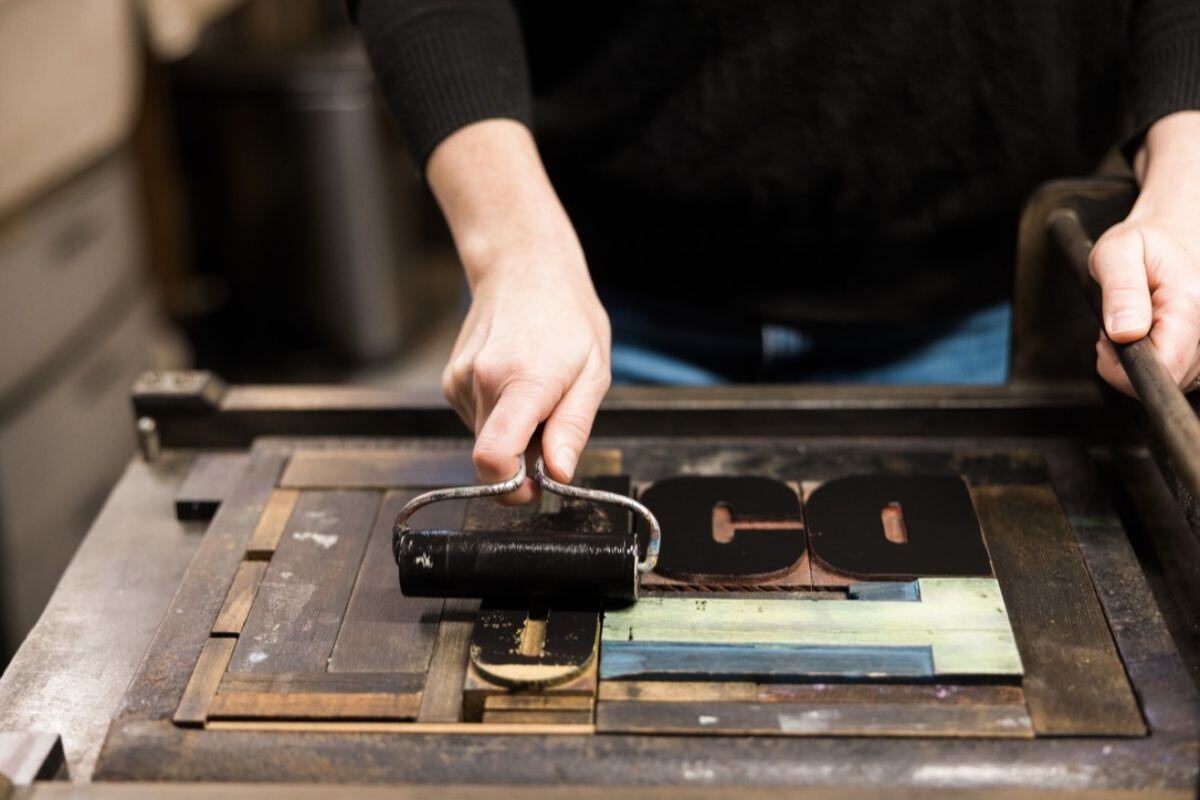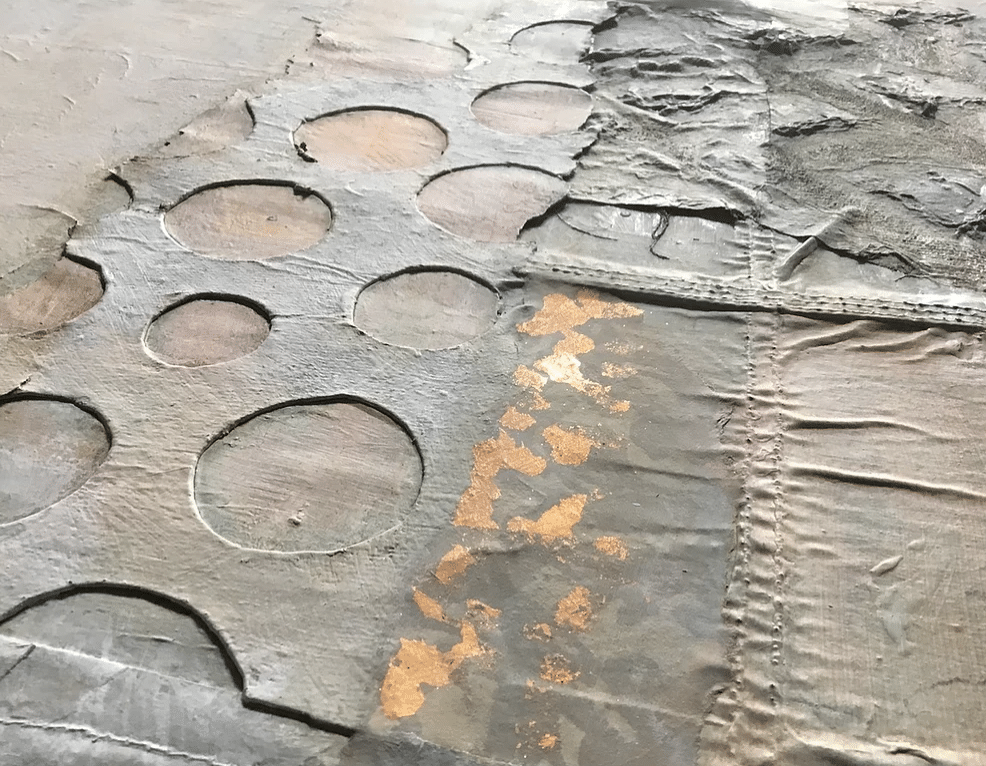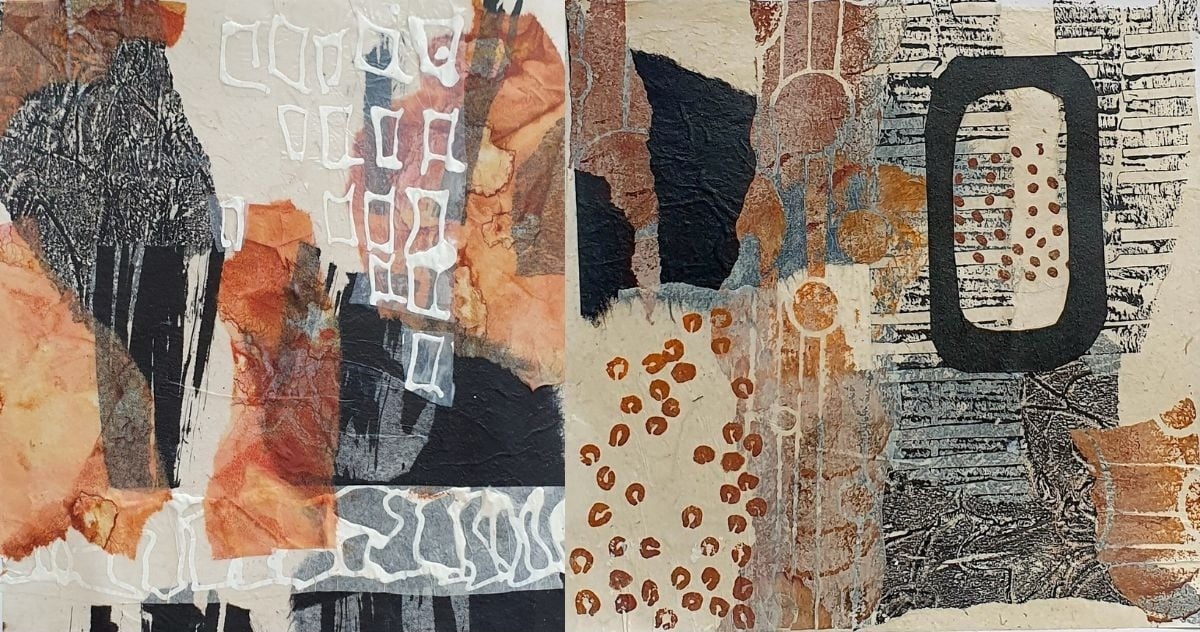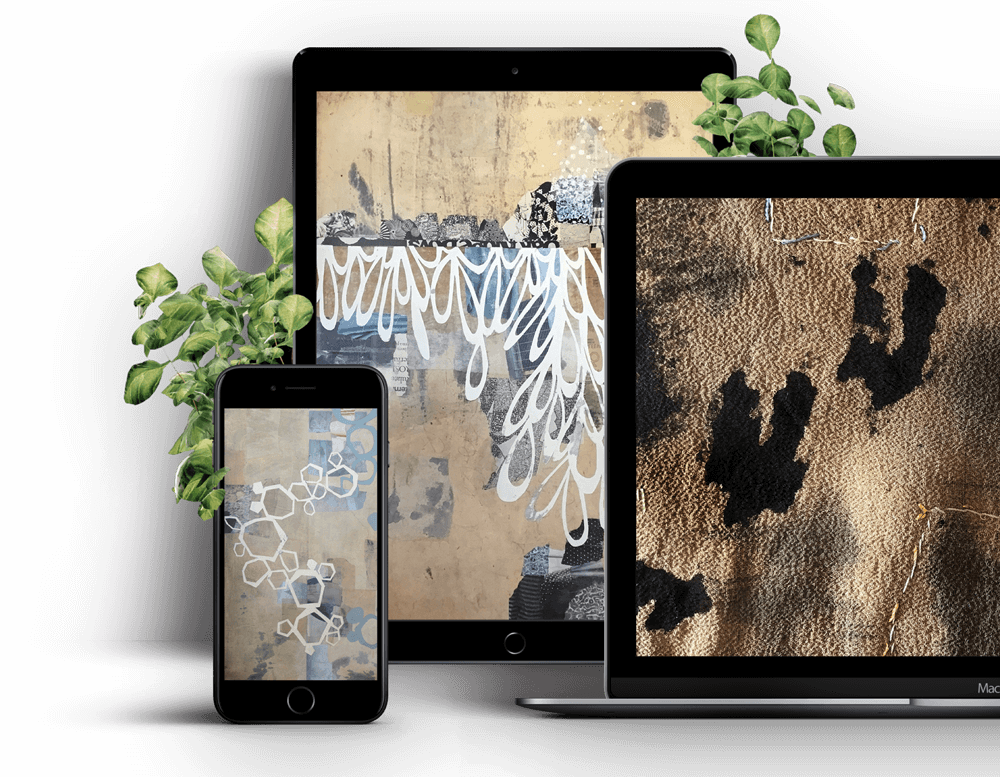Karen Stamper: From Observation to Art
Karen Stamper’s creative talents turn boatyards and seascapes into stunning works of collage art. Karen joined Fibre Arts Take Two to discuss collages, sketchbooks, her inspiration and her process.
Karen Stamper's Friday Feature Artist Interview can be found at the bottom of this page.
A happy beachcomber in her childhood, Karen Stamper was drawn to the weathered beauty of the boatyard… faded painted wood, vivid scraps of plastic, brightly coloured fishing floats and nets; all sun-dried, sandblasted, salted and worn by time.
As an artist and traveller, Karen draws collages and paints, often beginning her work spontaneously with mark-making from observation. Her art has a ‘playful toughness’ as it celebrates the worn surfaces of harbours and urban shorelines.
While her compositions may appear abstract, recognisable elements remain. As Karen constructs and deconstructs to reveal dynamic, stripped-back forms, areas are scratched, sanded, repainted and recut until the patchwork of urban marks and worn textures come together.

Early Beginnings
Karen, who is based in Cambridge in the UK but grew up in East Yorkshire in Hull, has always had art as part of her life.
“I was always drawing; my Dad used to set us drawing homework on a Sunday evening,” explains Karen.
“I’m realising now how much my art is about the landscape from my childhood.” She explains, "I grew up in East Yorkshire in Hull, and my roots were the docks that are very industrial and full of urban shapes."
This gritty, Northern sensibility has become a hallmark of Karen’s work, even though she has travelled the world and also drawn inspiration from Mediterranean buildings and urban environments.
Although she began her artistic endeavours working with sketchbooks, printmaking and silkscreen printing, Karen was inspired to explore collage as a form of art making when she came across Matisse’s ‘The Snail’. She was fascinated by the ripped edges, pinholes and creases. “You remember standing in front of a piece of work that really gets you,” she says.
Over time, Karen’s work evolved from sketching to flat, square collages to more dynamic, three-dimensional compositions that include canvas and acrylic. "In one of the latest ones, I've really broken out of the square, and I'm really starting to get attracted to dangly bits of string and the way things are fixed together."

The Power of Sketch
Most of Karen’s creations stem from her sketchwork and she has always used sketch in some way or another.
"When I was first travelling, when I came to Australia and New Zealand and everywhere, I had a sketchbook. I had my SLR camera, and I would have a couple of pens. I remember I was just drawing the whole time. So I got good at drawing from observation."
Karen later discovered the joys of concertina sketchbooks, which allow her to work in a continuous, uninterrupted flow. "I love the way it never stops. You start something here and it goes on and on, travelling."
Karen’s advice for anyone intimidated by the blank page of a sketchbook is to start by buying a book, and then getting some “collage papers and some ink on there, then it’s ready when you’re ready. If you’re going somewhere, splash some colours appropriate for that place, stick some collage papers in and you’ll have something to respond to that will pull you in and get you going.”
When sketching, she emphasises the importance of focusing on shapes and lines, rather than trying to accurately depict a scene. "Shapes appear when I collage that aren't really in the scene I sketched. So it's a bit made up. It’s a mix of observing what's there and looking around and taking something from over here and adding it to the scene as well."
Once a sketch is created, Karen can walk away from it. “If I’ve been out sketching in the boatyard, often my sketchbook won’t even be open. I’ve been there, recorded and absorbed everything, including the sounds and smells of boats. I might leave the book open for a while, but I don’t try to scale up from a sketch.”

‘Kill Your Darlings’
As an artist, you sometimes have to be willing to remove or cover up parts of your work that you are particularly attached to or proud of if they are not serving the overall composition. This process of editing and letting go of cherished elements is an important part of refining and improving artworks.
“I recently held a workshop in York, working with sketchbooks. We made lots of marks and I told the students to ‘edit back in’ with white paper.” This technique involves ripping up white paper into small pieces, and laying it on top, so you don’t have to commit to something. “Sometimes you’ll cover bits that are so beautiful, but realise that they have to go.”
Sometimes you have to ‘kill your darlings’ to make progress!
“The worst is if you just leave something there because it's precious, but it's not helping you develop,” explains Karen.

About Karen Stamper
Karen grew up on the east coast of Yorkshire and was a happy beachcomber, attracted to paint-peeling wooden boats, gaudy plastic scraps and brightly coloured fishing floats. As a child she was free to wander, explore and collect. It’s these boatyard memories that have become Karen’s subject and the source of endless inspiration.
It was when she was a secondary school teacher that Karen developed her collage work. She combines found papers with layers of painted paper and water-based paint to create an integrated surface. Karen then takes this surface and deconstructs and constructs many times, so it’s scratched, sanded, repainted, and recut, until a patchwork of urban marks and worn surfaces bond together. Of course, as this collage work developed it has become increasingly physical, and Karen now incorporates wooden panels into her work.
Karen’s work celebrates the worn surfaces and structures of the urban; coastal shoreline, harbours and boats. She captures the essence of a subject and the sense of human presence, echoing the passing of time.
Join Our Newsletter
OUR YOUTUBE CHANNEL
View our interviews and more on our Youtube channel!
OUR FACEBOOK GROUP
Join our Community and stay updated with our upcoming announcements!




